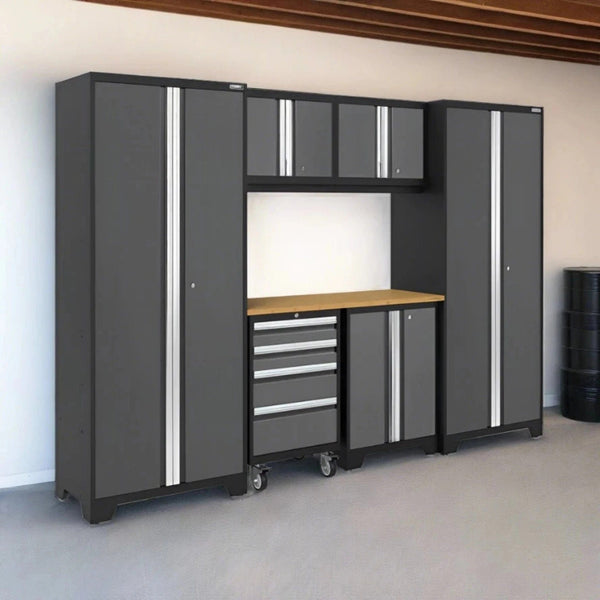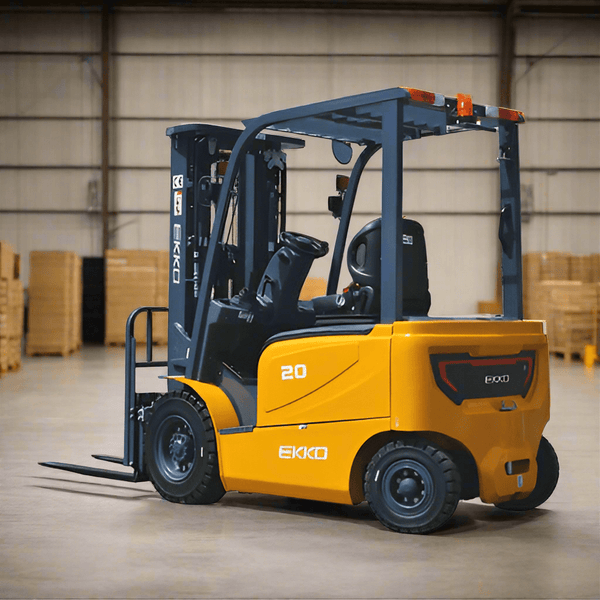
Do 4-Post Lifts Need to Be Bolted Down?
You want complete confidence in your setup if you’re going to raise a vehicle off the ground and work or park beneath it. So do 4-post lifts need to be bolted down? We get asked this all the time here at My Garage Supplies, and we’re going to address it once and for all.
Ultimately, it depends on how you plan to use it. Most 4-post lifts are designed to operate safely without anchoring for light-duty applications like residential vehicle storage. These freestanding models use wide baseplates for stability and may come with caster kits so you can move the lift.
On the other hand, bolting down becomes a smart move (or even a requirement) if you’re using the lift in a commercial setting, working on heavier vehicles, or loading/unloading frequently. This helps reduce lateral shift and maximizes safety.
Learn more about the installation guidelines for various 4-post lifts below. But no matter which approach you take, your search for a safe and reliable 4-post car lift ends here at My Garage Supplies.
We’ve handpicked our lineup from the most trusted brands in the industry, including AMGO, Atlas, and Triumph. So whether you’re stacking cars in your home garage or running a high-traffic repair bay, we’ve got a lift built for how you work and how you want to install it!
The Benefits of a 4-Post Car Lift
These drive-on vehicle lifting systems are supported by four upright columns and two long runways. The vehicle is raised by hydraulic power and held securely by mechanical safety locks.
While 2-post lifts raise a car from the frame at four contact points, 4-post lifts raise the entire vehicle by its wheels. They’re really stable and great for storage, along with many different types of general service work.
Ease of use is the biggest benefit of a 4-post lift, as you can simply drive onto the runways and raise the vehicle. No need to align lift arms or get under the car to position pads. These lifts are ideal for stacking vehicles in residential garages or for handling oil changes, exhaust work, and inspections in commercial shops.
Many models can be enhanced with accessories like rolling jacks, which lets you lift all four wheels off the runways when needed. You can learn more about the differences between a 2-post lift vs 4-post lift in our blog if you’d like. Let’s get to the main topic at hand today.
Do 4-Post Lifts Need to Be Bolted Down?
So do 4-post lifts need to be bolted down? The short answer is in some cases yes, in others, no. This is part of the appeal of these lifts: they’re very flexible in how you can use them.
Their wide baseplates and balanced load distribution keeps them stable out of the box without any bolting whatsoever. Still, there are cases when a lift should be bolted down. It all depends on how it’s being used, the type of lift, and the surface it’s installed on.
When Bolting a 4-Post Lift Is Required
Bolting a 4-post lift to the concrete is often necessary for safety and compliance in commercial or high-traffic settings. These applications involve loading and unloading heavy vehicles multiple times a day, usually working on them while raised.
Anchoring the lift prevents lateral movement and minimizes long-term wear in these cases, providing a bit more assurance of safety. Some municipalities or insurance policies may even require bolted lifts in professional shops.
Bolting is especially important if your concrete slab is uneven, thin, or untested. It can compensate for flooring flaws and prevent shifting or instability over time.
We also recommend bolting your lift if it’s going to stay in a fixed position long-term. If that’s the case, there’s really no reason to sacrifice stability for movement. That said, there are many cases where you want to be able to move the lift around.
When 4-Post Lifts Can Be Safely Used Freestanding
Most residential-grade 4-post lifts (rated around 8,000-9,000 lbs) are designed to be used without anchors. They have wide enough baseplates to distribute weight evenly across four columns, so they’re plenty stable on their own for something simple like car storage.
Many freestanding models also support caster kits, giving you the ability to move the lift within the garage when needed. This is great if you are tight on space and want to maximize every inch possible.
Bolting it down likely isn’t necessary if you’re using the lift for occasional oil changes, detailing, or long-term car storage. However, you must install it on a level concrete slab that meets the manufacturer’s minimum thickness and PSI standards (typically 4” at 3,000 PSI or higher).
The Risks of Skipping Anchoring When It’s Needed
Now, why do 4-post lifts need to be bolted down? Even though freestanding operation is safe under the right conditions, using a non-anchored lift in high-demand environments can introduce real risks.
Repeated side loading (such as rolling jacks or lateral pressure from pushing/pulling vehicles) can cause the lift to shift slightly over time. This can lead to uneven lifting on unlevel slabs, putting more stress on structural components, in turn wearing out cables and locks faster.
A severe imbalance or misuse could cause a freestanding lift to tip or slide in rare cases, particularly when it’s overloaded or improperly installed. It’s rare, but the risk exists - and that alone is reason enough to anchor if you can!
Manufacturer Guidelines on Bolting Requirements
Every lift brand outlines its own anchoring recommendations. These are your best guidelines when asking, do 4-post lifts need to be bolted down? Here’s an overview of some of the top car lift brands we carry here at My Garage Supplies:
- AMGO PRO series: Freestanding by design for residential users, but commercial use often calls for anchoring.
- Atlas Garage PRO models: Clearly marketed as portable and include caster kits, but advise bolting for permanent setups or heavier vehicles.
- Triumph and others: Offer both portable and bolt-down options. Anchoring is usually required above 9,000-10,000 lb capacity or when installing accessories like rolling jacks.
Always refer to the lift’s installation manual. Manufacturer guidance will cover minimum concrete specs, torque settings, and whether anchoring is mandatory, recommended, or optional depending on the application.
Ignoring these specs isn’t just dangerous, it could also void warranties or put you in compliance trouble if you run a commercial shop. Let’s touch on a few other factors to keep in mind when choosing/installign a lift before wrapping things up.
More Things to Think About When Choosing and Installing a 4-Post Car Lift
From understanding the car lift concrete requirements to power supply specs, there’s a lot that goes into bringing the benefits of a 4-post car lift into your garage. We can help you navigate all this at My Garage Supplies. In the meantime, here’s what you need to consider.
Check Your Garage Floor Specifications
Confirm that your garage slab meets the manufacturer’s minimum requirements before even purchasing a vehicle lift. The last thing you want is to find out your slab falls short and be forced to deal with returns.
Most manufacturers require at least 4 inches of concrete thickness at 3,000 PSI for the slab. Uneven or under-poured concrete can compromise the lift’s stability, especially if you plan to anchor it. Use a core drill or consult a contractor if you’re unsure of your slab’s specs.
Power Supply and Circuit Requirements
Most 4-post lifts run on either a 110V or 220V outlet depending on the motor. Some residential models run on standard household power, while commercial lifts may need dedicated 220V service.
Always confirm amperage requirements and protect the circuit with the appropriate breaker or GFCI setup. This is something a licensed electrician can help you figure out if you need assistance.
Vehicle Dimensions and Weight
Make sure your vehicle’s length and wheelbase fit within the lift’s runway. You should also double-check the lift’s maximum weight rating, accounting for the weight of anything stored in or on the vehicle. Overloading is a leading cause of wear and early failure.
Ongoing Safety and Maintenance Considerations
Even a well-installed lift needs periodic lubrication and torque checks to stay safe. So, plan to regularly inspect cables, locks, and hydraulic components. Consider future access needs too, leaving plenty of clearance for walking space and tool access around the lift.
Find the Perfect 4-Post Lift at My Garage Supplies Today!
Whether you’re looking for the perfect 4-post lift or a scissor lift vs 2-post lift, My Garage Supplies is your trusted choice for dependable car lift online.
We stock a wide range of lifts to suit residential garages and busy commercial shops alike. Our collection includes trusted names like AMGO, Atlas, and Triumph, with lift capacities ranging from 8,000 to 14,000 lbs.
Whether you need a freestanding model for vehicle storage or a heavy-duty lift for daily shop work, every lift is built for strength, ease of use, and long-term reliability. We only source from US-based supplier, and your purchase is protected by expert support from our team.
You can also consider our 2-post car lift or single-post car lift collection. Just reach out if you’re not sure which model is right for your space. We’ll guide you through the specs and help you choose a lift you can trust.
Parting Thoughts on Bolting Down 4-Post Lifts
So, do 4-post lifts need to be bolted down? Hopefully you have a solid grasp of what makes the most sense for your specific garage. Bolting a 4-post lift isn’t always required, although it can make a real difference for safety and security in some cases.
Freestanding models can work safely for many home users, while commercial setups or heavier use often demand anchoring for added stability and safety. The key is matching the lift, installation, and use case to your specific needs.
From the best residential garage car lifts to symmetric vs asymmetric lifts for commercial settings, your search for the perfect vehicle lift ends here at My Garage Supplies.
We’ve got the options and expertise to help you get it right the first time if you're looking for a lift that fits your garage and how you work. Don’t play the guessing game. Get in touch today to take the next step!



